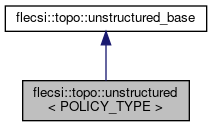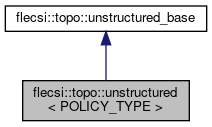#include <interface.hh>


Classes | |
| struct | access |
Public Member Functions | |
| unstructured (const coloring &) | |
Additional Inherited Members | |
 Public Types inherited from flecsi::topo::unstructured_base Public Types inherited from flecsi::topo::unstructured_base | |
| using | coloring = size_t |
unstructured is parameterized on a class (POLICY_TYPE) which gives information about its entity types, connectivities and more. the mesh topology is responsibly for computing connectivity info between entities of different topological dimension, e.g: vertex -> cell, cell -> edge, etc. and provides methods for traversing these adjancies. It also holds vectors containing the entity instances.
Description of major features and terms specific to FleCSI:
mesh dimension MD - e.g: MD = 2 for a 2d mesh. We currently support 2d and 3d meshes.
topological dimension D - the dimensionality associated with entities, e.g: D = 0 is interpreted as a vertex, D = 1 an edge or face for MD = 2, D = 2 is a cell for MD = 2
domain M - a sub-mesh or mesh space that holds entities of various topological dimension
connectivity - a directed connection or adjancy between entities of differing topological dimension in the same domain. e.g: D1 -> D2 (edges -> faces) for MD = 3. Cell to vertex connectivity is supplied by the user and all other connectivies are computed by the topology.
binding - a type of connectivity that connects entities of potentially differing topological dimension across two different domains
entity - an object associated with a topological dimension, e.g: cell. Each entity has an associated integer id.
mesh topology - the top-level container for domains, entities, and connectivities, referred to as the low-level interface
mesh policy - the top-level class that a specialization creates to parameterize the mesh topology to define such things as: mesh dimension, number of domains, connectivity and binding pairs of interest, and entity classes/types per each domain/topological dimension.
entity set - contains an iterable set of entities. Support set operations such as intersection, union, etc. and functional operations like apply, map, reduce, etc. to apply a custom function to the set.
| POLICY_TYPE | mesh policy type by which the mesh is statically configured. |
 1.8.13
1.8.13